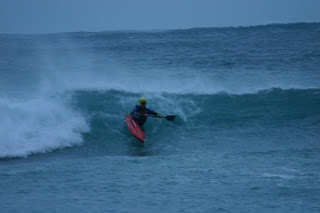
I’ve been thinking about decision making in relation to kayaking. Trying to figure out, if I have a group, what questions I should ask myself about the situation, and what order I should do things in. I like having rules for approaching things because it makes that approach simpler. I was also thinking about the minimum things that I would want to know about a group and a trip that we were going to do, and then other things beyond the minimum that I’d like to know. What I’ve come up with is this:
For any kayaking session, the first thing I want to know is my group’s experience. From that, the second thing that we will do is come up with a plan for what we’re going to do, i.e. goals. The third thing that follows on is a risk assessment for that plan or those goals. These three things are all already defined for things that are completely standard, however for other things (for example expeditions), they change here and there, so we have to adapt and be flexible. I like to categorise them in to generic (things that could happen anywhere) and specific (which are the varying components of the risk assessment).
I then thought that pretty much all our activity, whether it’s kayaking, or sitting at a computer, has goals that we want to achieve, whether that’s typing a letter, or watching the sun go down. And a risk assessment can be done for any of those goals. In my formal risk assessment, I write preventative and reactive action, in relation to a risk.
So, to cut a long story short, after formalising the process in my head, I now feel like I can approach any situation, automatically carrying out a risk assessment, and dynamically assessing the risk as the situation flows.
Looking forward to a bit of surf kayaking this weekend, as the F9 gale blowing outside whips up some swell…


 After dinner, the solitude got to me a bit. Being alone on another island was a bit lonely at first. Eventually I resorted to talking to myself, which was surprisingly comforting, and as the evening went on, I listened to the MP3s on my phone. I had forgotten that I didn’t have credit on my sim card, so had to wait up on the hill (where I had a signal) for 2 hours for the phone call at 9pm from my folks, which I said I would make at 8pm. I was glad they phoned, because I wouldn’t have been able to sleep if I was half expecting the lifeboat to come round the corner in the middle of the night. It was a long night.
After dinner, the solitude got to me a bit. Being alone on another island was a bit lonely at first. Eventually I resorted to talking to myself, which was surprisingly comforting, and as the evening went on, I listened to the MP3s on my phone. I had forgotten that I didn’t have credit on my sim card, so had to wait up on the hill (where I had a signal) for 2 hours for the phone call at 9pm from my folks, which I said I would make at 8pm. I was glad they phoned, because I wouldn’t have been able to sleep if I was half expecting the lifeboat to come round the corner in the middle of the night. It was a long night. I knew the swell round the west coast of Sandray was going to be awesome - I had to do it! I couldn’t resist seeing what the sea was like. The swell was indeed awesome! Scary at first, the power of it and what it could to do someone if they were in the wrong place at the wrong time felt surreal, so I kept my distance from the rocks. No photos as all I had was my phone for pictures. Progress was slow into the wind, and bouncing around in the clapotis. Out of the clapotis, it wasn’t too bad. The long rolling swell passed underneath me. Sometimes in the trough, I’m sure the swell must have been 12-15ft at times. Intimidating at first, but it was surprising how I got used to it.
I knew the swell round the west coast of Sandray was going to be awesome - I had to do it! I couldn’t resist seeing what the sea was like. The swell was indeed awesome! Scary at first, the power of it and what it could to do someone if they were in the wrong place at the wrong time felt surreal, so I kept my distance from the rocks. No photos as all I had was my phone for pictures. Progress was slow into the wind, and bouncing around in the clapotis. Out of the clapotis, it wasn’t too bad. The long rolling swell passed underneath me. Sometimes in the trough, I’m sure the swell must have been 12-15ft at times. Intimidating at first, but it was surprising how I got used to it.






